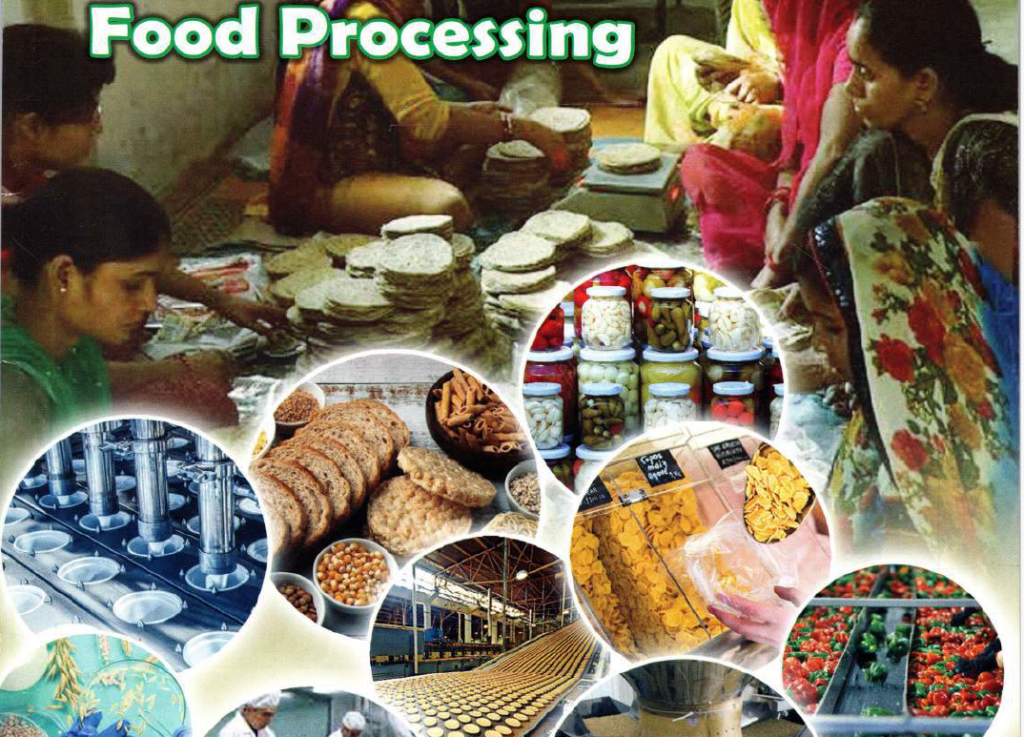India with its agricultural tradition and diverse climate, holds immense potential for the food processing sector. This industry is not only a cornerstone for the country’s economic growth but is also pivotal for ensuring food security, reducing wastage, enhancing farmers’ incomes and providing employment opportunities.
In order to achieve a developed nation status in the next 25 years, the food processing sector would be crucial in transforming India’s primary agriculture sector with enhanced productivity and profitability while ensuring sustainability and resilience.

What is Food Processing? What are the reasons behind its growing Demand in India?
Food Processing- It involves transforming raw agricultural products into consumable food items, adding value and extending shelf life. Food processing sector has been recognised as a ‘sunrise sector‘ and a key priority industry under the ‘Make in India’ initiative.
Type of Food Processing- The can be categorized into primary and secondary products.
a. Primary products are made from processed raw materials, like fruits and vegetables.
b. Secondary products are created by processing primary food items into new products, such as jams, sauces, and butter.
Main reasons behind the Growth of Food Processing sector in India
a. Changing lifestyle and food preferences as a result of increasing disposable income. Rising health consciousness among consumers is driving demand for processed and packaged foods that
are safe and nutritive.
b. High level of agricultural output– India is the world’s largest producer of milk, pulses, and jute. It is also the second largest producer of essential crops such as rice, wheat, sugarcane, groundnut, vegetables, fruits, and cotton.
c. Export opportunities such as proximity to key export destinations, increasing connectivity with the global economy.
d. Proactive government policy and assistance with government interventions like Mega Food Park Scheme.
What is the significance of the Food Processing Sector?
1. Increased Contribution to GDP- The food processing sector has emerged as an important segment of the Indian economy in terms of its contribution to GDP. During the last 5 years the sector had
grown at an average annual growth rate of around 8.3% as compared to around 4.87% in the agriculture and allied sectors (at 2011-12 prices).

2. Employment Generation- This sector is a major employment generator in the country. As per the latest Annual Survey of Industries (ASI) for 2019-20, the total number of persons engaged in the registered food processing sector was 20.32 lakhs. Moreover as per the NSSO 73rd Round, 2015-16, the unregistered units of the sector supported employment for 51.11 lakh workers and constituted 14.18% of employment in the unregistered manufacturing sector.

3. Large FDI inflow and market size- FDI equity inflows into the food processing sector reached $3.28 billion between 2019-2022. It is the fifth largest sector of the country’s economy.
4. Promotes balanced regional development- This industry is a sunrise industry with a consistent demand for locally processed food. This promotes balanced regional development in the country.
5. Women entrepreneurship- The sector provides employment opportunities to rural women in India and also serves as a platform for entrepreneurship. For ex- Lijjat papad venture.
6. Nutritional Improvement- Processed foods can be fortified with essential vitamins and minerals, thereby addressing malnutrition and improving public health outcomes.
What are the Government schemes and initiatives for promotion of Food Processing Sector in India?
| Pradhan Mantri Kisan Sampada Yojana (PMKSY) | This Central Sector Scheme is being implemented across the country to facilitate the creation of modern infrastructure with efficient supply chain management from farm gate to retail outlet for promotion. |
| Pradhan Mantri Formalisation of Food Processing Enterprises (PMFME) | It was launched in June 2020 to encourage ‘Vocal for Local‘ in the sector with a total outlay of Rs. 10,OOO crore during the period 2020-2025. The scheme aims to enhance the competitiveness of individual microenterprises in the unorganised segment of the food processing industry and promote formalisation of the sector. This is the first ever Government scheme for Micro Food Processing enterprises and is targeted to benefit 2 lakh enterprises through credit linked subsidies and adopting the approach of ‘One District One Product‘. |
| Food Processing Fund | The Government of India instituted the Food Processing Fund (FPF) in NABARD during 2014-15, with a corpus of Rs. 2,000 crore, with the objective of providing affordable credit to public and private players for setting up of Designated Food Parks (DFPs) |
| Warehouse Corpus Fund | The fund was set up corpus of Rs. 5000 crore to support State governments, State-owned agencies, and Corporates for the creation of scientific warehouse capacity through financial support. |
| Production Linked Incentive Scheme | The scheme aims to generate employment for approximately 2.5 lakh persons. |
| Mega Food Park Scheme | Mega Food Parks are built on a ‘cluster’ strategy and focus on the development of cutting-edge support infrastructure in a well-defined agri/horticultural zone for the establishment of modern food processing units. |
What are the Challenges faced by the Sector In India?
1. Low GVA despite high demand- Despite the increasing demand for processed food and ready-to-eat food in India, the share of the sector in overall GVA has only been 1.88% (2020-21) as against the share of manufacturing at 17.86% and the share of GVA in agriculture at 16.26%.
2. Lack of skilled manpower and modern technology- The availability of skilled manpower has been identified as one of the major challenges facing the industry in India. Many processing facilities use outdated technologies, reducing efficiency and product quality.
3. Infrastructure Bottlenecks- Inadequate cold storage facilities, transportation systems, and processing infrastructure result in post-harvest losses exceeding 30% of produce. The NITI Aayog estimates annual post-harvest losses close to Rs 90,000 crore.
4. Informalization and Unorganized Segments- The sector has a high concentration of unorganized segments, representing almost 75% across product categories. This causes inefficiencies in the production system.
5. Supply Chain Inefficiencies- Fragmented supply chains with multiple stakeholders and poor coordination lead to delays, waste, and low quality products. For ex- Broken supply chain in the agricultural hinterland of Bihar.
6. Regulatory Challenges- Stringent sanitary and phytosanitary (SPS) measures in export markets impede Indian processed food exports. For ex- Rejection of Indian processed exports by the EU.
| Read More- [Kurukshetra Feb 2024 Summary] Food Storage Infrastructure- Explained Pointwise |
What Should be the Way Forward?
1. Use of Smart technologies- Internet of Things (IOT), Artificial Intelligence (AI) Applications, Robotics and Automation should be used in the food processing sector to increase productivity and decrease wastage.
2. Focus on horticulture and animal products- Special focus must be put on making India a market leader in global trade for at least five value chains- processed fruits and vegetables, processed fish and sea food, meat, dairy products, poultry and eggs by 2047.
3. Skilled Manpower- The food sector must employ more professionals trained in food technology, quality control, processing methods, and food safety management.
4. Better health markers- It must involve better health markers on the packets. The regulatory mechanism governing food safety must be strengthened and properly governed.
5. Tapping the popularity of agricultural products- There is also a need to tap the popularity of various food grains and coarse grains like millets which are gaining increasing importance due to their nutritional benefits and adaptability to various climatic conditions.
| Read More- The Hindu Yojana articles Covered- Article 1, 3, 4, 6, and 7 UPSC Syllabus- GS 3- Indian Agriculture |
Discover more from Free UPSC IAS Preparation Syllabus and Materials For Aspirants
Subscribe to get the latest posts sent to your email.





